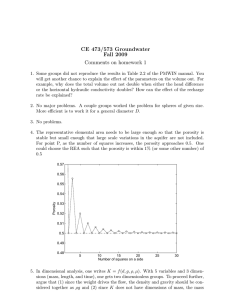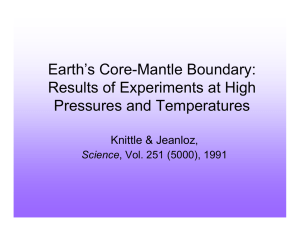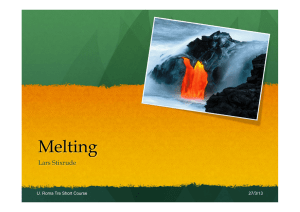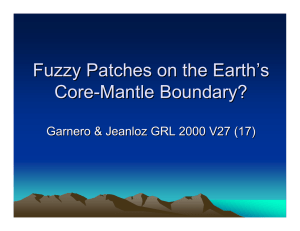Sediments at the top of the Earth’s core Garnero, and Raymond Jeanloz
advertisement
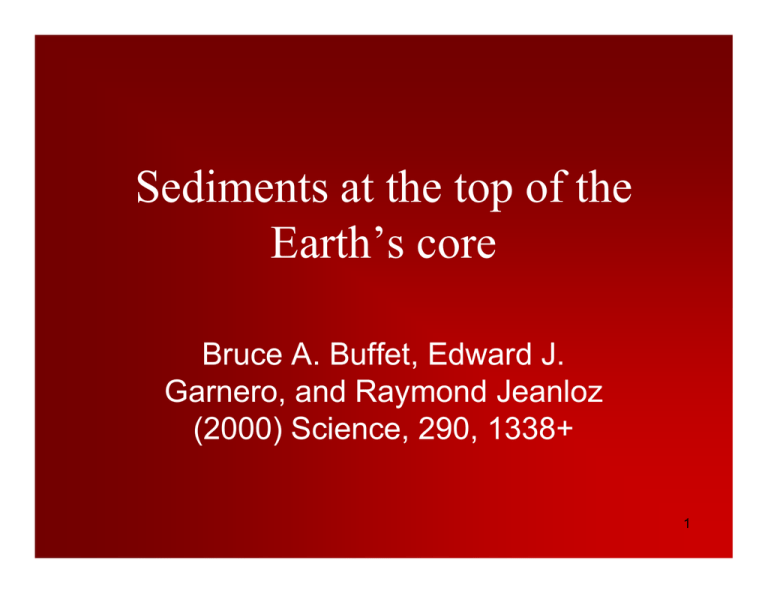
Sediments at the top of the Earth’s core Bruce A. Buffet, Edward J. Garnero, and Raymond Jeanloz (2000) Science, 290, 1338+ 1 What is a sediment? • Sediment = material derived from preexisting rock, from biogenic sources, or precipitated by chemical processes, and deposited at, or near, Earth’s surface. • Sedimentary rock = rock formed by the deposition and compression of mineral and rock particles, but often including material of organic origin and exposed by various agencies of denudation. From: Oxford Dictionary of Earth Sciences 2 Evidence for unusual physical properties at CMB • ULVZ → layer of partial melt?? • Nutation of Earth’s rotation → conductive layer ~1.7x108 S (> silicates). • Predictions of the amplitude of the dominant periodicity of nutations → conductive layer From: Buffet et al. (2000) Science 3 Earth’s nutation MOVIE NUTATION From: Observatoire de Paris Immobile (relative to flow in the core) layer with finite rigidity at the top of the core, with conductance ~108 S exists in the lowermost 200 m of the mantle. From: http://www.pietro.org/Astro_Util_StaticDemo/MethodsNutationVisualized.htm 4 Time-scales Changes in the mantle structure ~108 yr Convection in the core ~103 yr → core is in chemical equilibrium with the base of the mantle 5 Cooling and solidification of the inner core → Segregation of lighter elements into the outer core (Mg y , Fe1− y )SiO3 + 3(1 − y )Fe ⎯ ⎯→ yMgSiO3 + (1 − y )FeSi + 3(1 − y )FeO NB: No stishovite term in RHS! From: Buffet et al. (2000) Science Increase of concentrations on the RHS → REACTION REVERSES! 6 Assumptions • 1 mol FeX → 1 mol silicate • Sediments ~ lower mantle ρsed = 5570 kg m-3 vsedP= 13.72 kg s-1 vsedS= 7.26 kg s-1 msed=108 g [(Mg0.85,Fe0.15)SiO3] 7 Assumptions continued • Core is well mixed • Core has constant density 9900 kg m-3 • MX, out oc = MX, out ic • MX, out ic = ∆C·Mic. ∆C is the change of mass fraction of X across the IOB • Msed = (msed/mX)MX, out ic m = molar mass 8 Upside-down sedimentation • Sediment front moves downward with time • Topographic highs on the CMB are depositional basins 9 The model • Initial porosity Φ0=0.5, this is also a boundary condition on the lower interface dVsed 1 dM sed = dt ρ sed Φ 0 dt ⎛ ρ c ⎞⎛ msed dVsed ⎟⎟⎜⎜ = ∆C ⎜⎜ dt ρ Φ ⎝ sed 0 ⎠⎝ m X ⎞ dVic ⎟⎟ ⎠ dt Vic (t ) = (t / τ ) Vic (τ ) 3/ 2 estimate: dVsed dt Ric ~ t1/2 Ric(tau) = 1221 km tau = 2x109 yr dVic ≈1 dt 10 Compaction Interconnectedness Does liquid Fe wet the surface of silicate minerals at high T&P? OR Do isolated pockets of liquid Fe develop within the layer as the porosity increases? → Silicate permeable to liquid Fe Φa k= 2 K (1 − Φ ) 3 2 Kozeny-Carman relation k=permeability a=grain size of sediments=10-7 m K=constant factor Resistance to compaction What is the effective bulk viscosity of the sediments? Shear viscosity lower mantle= 1022 Pa s Viscosity liquid Fe = 10-2 Pa s 11 Results 1. 2. 3. Porosity at lower interface = Φ0. Rapid decrease of porosity to 0.05 over 1.5 km. Nearly uniform porosity deeper than 1.5 km into the layer. Permeability is low enough to inhibit expulsion of liquid iron. Liquid P increases due to compaction, opposes buoyancy forces and limits further consolidation. From: Buffet et al. (2000) Science L= η s dVsed Ased dt NB: A↓ (e.g. sedimentation in topographic highs) → L↑ 12 Results continued From: Buffet et al. (2000) Science Thickness of the anomalous zone (coinciding with region of high porosity) and relative and absolute velocity reductions are large enough to provide a viable explanation for the ULVZ. 13 Conclusions • Observations of nutation indicate a conductive region at the CMB. • Sediments are not necessary, but possible explanation. The model predicts velocity and density perturbations which fit in well with ULVZ. • L=ULVZ? Thickness of anomalous zone is a only few (1-2) km. • Possible entrainment of low residual porosity zone into mantle convection (signature in plumes?) • Possible correlation between location of ULVZ’s and topographic highs on the CMB. 14
